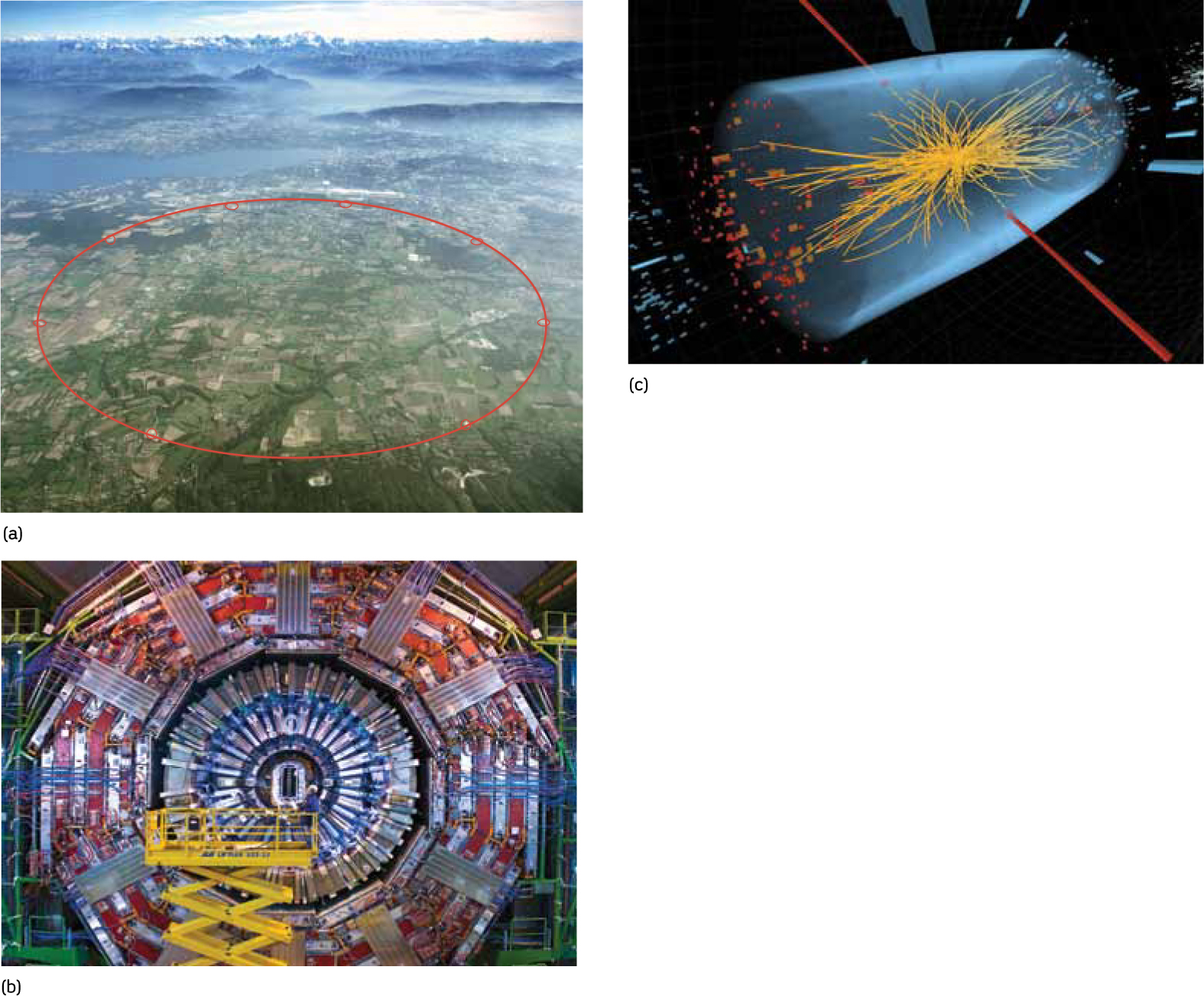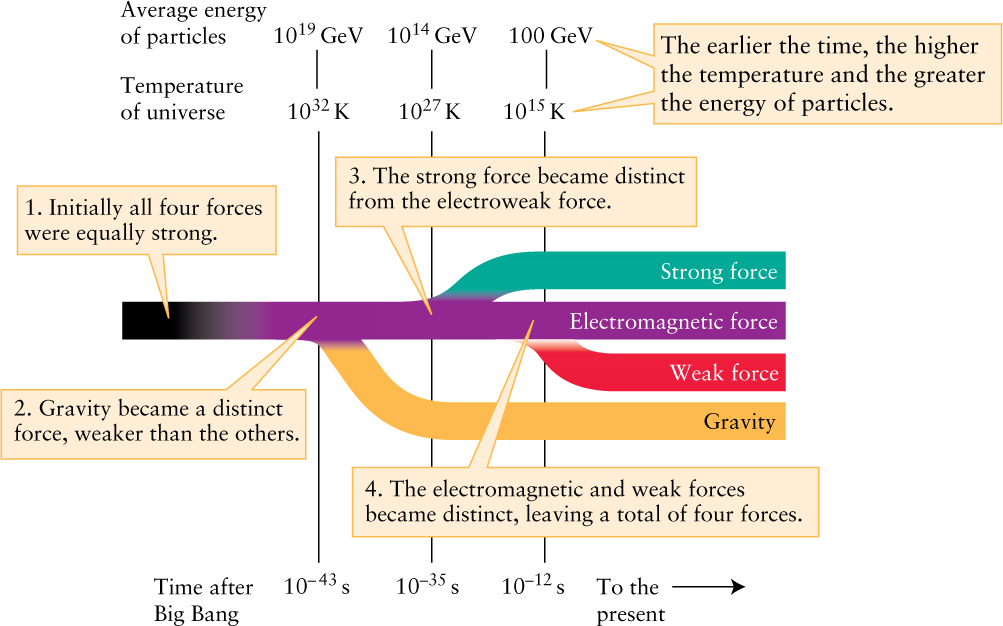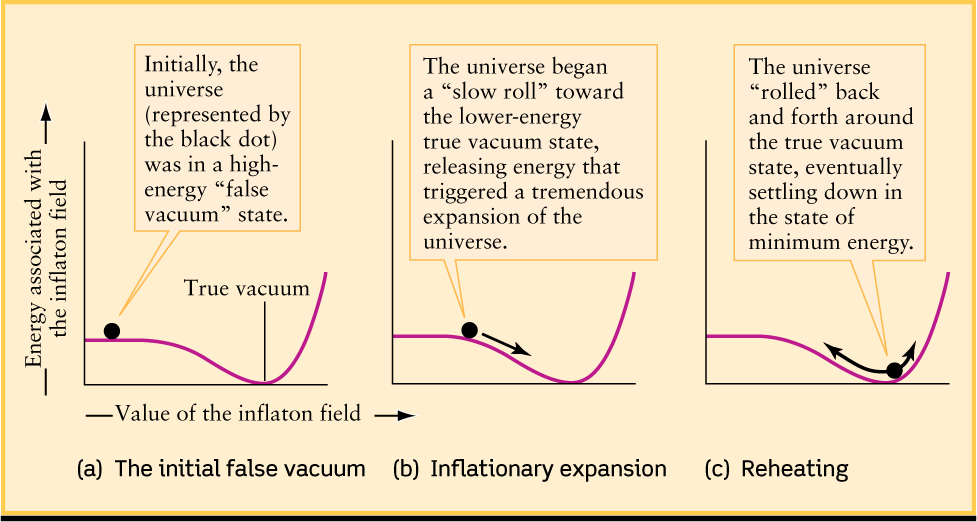26-2 Inflation extends the principles that govern the fundamental forces of nature
If the universe went through an episode of extreme inflation, what could have triggered it? Our understanding is that inflation was one of a sequence of remarkable events during the first 10−12 seconds after the Big Bang. In each of these events there was a fundamental transformation of the basic physical properties of the universe. To understand what happened during that brief moment of time, when the universe was a hot, dense sea of fast-moving particles and energetic photons colliding with each other, we must first understand how particles interact at very high energies.
The Fundamental Forces of Nature and the Standard Model
Just four fundamental forces—gravitation, electromagnetism, and the strong and weak forces—explain the interactions of everything in the universe. Of these forces, gravitation is the most familiar (Figure 26-6a). It is a long-range force that dominates the universe over astronomical distances. Electromagnetism, which accounts for the electric and magnetic forces, creates a long-range force, but it is intrinsically much stronger than the gravitational force. For example, the electric force between an electron and a proton is about 1039 times stronger than the gravitational force between those two particles. Because the electromagnetic force is stronger by a factor of 1039, electromagnetism, not the gravitation, holds electrons in orbit about the nuclei in atoms.

We do not generally observe longer-range effects of the electromagnetic force, because there is usually a negative electric charge for every positive charge and a south magnetic pole for every north magnetic pole. Thus, over great volumes of space the effects of electromagnetism effectively cancel out. No similar canceling occurs with gravity because there is no equivalent “negative mass.” Because the effects of gravity do not cancel out, the force that holds Earth in orbit around the Sun is gravitational, not electromagnetic.
The strong force holds protons and neutrons together to form the nuclei of atoms (Figure 26-6b). It is said to be a short-range force: Its influence extends only over distances less than about 10−15 m, about the diameter of a proton. Without the strong force, nuclei would disintegrate because of the electric repulsion of the positively charged protons. In fact, the strong force overpowers the electric forces inside nuclei. While there are technical differences, the strong force is also referred to as the nuclear force.
The weak force, which also is a short-range force, is at work in certain kinds of radioactive decay (Figure 26-6c). An example is the transformation of a neutron (n) into a proton (p), in which an electron (e−) is released along with a nearly massless particle called an antineutrino  :
:


Numerous experiments in nuclear physics demonstrate that protons and neutrons are themselves composed of even more basic particles called quarks, the most common varieties being “up” (u) quarks and “down” (d) quarks. A proton is composed of two up quarks and one down quark, a neutron of two down quarks and one up quark.
In the 1970s the concept of quarks led to a breakthrough in our understanding of the strong and weak forces. The strong force holds quarks together, while the weak force is at work whenever a quark changes from one variety to another. For example, when a neutron decays into a proton, one of the neutron’s down quarks changes into an up quark, as shown in Figure 26-6c. Thus, the weak force is responsible for transformations such as

In the 1940s, physicists Richard P. Feynman and Julian S. Schwinger (working independently in the United States) and Sin–Itiro Tomonaga (in Japan) succeeded in developing a basic description of what we mean by force. Focusing their attention on the electromagnetic force, they tried to describe exactly what happens when two charged particles interact. According to their theory, now called quantum electrodynamics, charged particles interact by exchanging virtual photons that cannot be directly observed. (These virtual photons will be explored further in Section 26-3.)
Experimental and theoretical research into the basic forces of nature helps us understand the evolution of the cosmos
Quantum electrodynamics has proved the most successful theory in modern physics. It describes with remarkable accuracy many details of electromagnetic forces and interactions between charged particles. Inspired by these successes, physicists developed similar theories for the other three forces. A key feature of a microscopic description of force is that two particles exert a force on each other by exchanging a third and different particle (Figure 26-7). For example, the weak force occurs when particles exchange particles called intermediate vector bosons, and quarks stick together by exchanging elementary particles called gluons. These theories have been verified by experiments, and our overall understanding of the known particles is called the Standard Model (Figure 26-6d). The table in Figure 26-6 summarizes these features of the four fundamental forces.
CONCEPT CHECK 26-3
A neutron consists of one up quark (u) and two down quarks (d) as in Figure 26-6c. Are there any other particles in the Standard Model that you would expect to be involved in holding a neutron together?
Yes. The up and down quarks are held together by the strong force. Since the strong force is transmitted by gluons, these gluons are also involved in holding a neutron together.
Experimentally Verified Unification Theories and the Higgs Particle
Physicists made important progress in understanding the weak force during the 1970s. Steven Weinberg, Sheldon Glashow, and Abdus Salam proposed a theory with three types of intermediate vector bosons, which are exchanged in various manifestations of the weak force. These three particles were actually discovered in experiments in the 1980s, providing strong support for the theory.
A startling prediction of the Weinberg-Glashow-Salam theory is that the weak force and the electromagnetic force should be identical to each other for particles with energies greater than 100 GeV. (One GeV equals 109, or 1 billion, electron volts; see Section 5-5.) In other words, if particles are slammed together with a total energy greater than 100 GeV, then electromagnetic interactions become indistinguishable from weak interactions. We say that above 100 GeV the electromagnetic force and the weak force are “unified” into a single electroweak force. This is our first example of the “unification” of forces, and the only one to be experimentally verified.
This unification occurs because the three types of intermediate vector bosons behave just like photons above 100 GeV. At such high energies, these three particles actually lose their mass, and the weak force becomes a long-range force with the same intrinsic strength as electromagnetism. Physicists describe this similarity by saying that “symmetry is restored” above 100 GeV.
In the world around us, however, the typical energies with which particles interact are much lower, on the order of 1 eV or less. Below 100 GeV, intermediate vector bosons behave like massive particles, but photons have no mass. Because intermediate vector bosons and photons are not similar at low energies, we say that “symmetry is broken” below 100 GeV, which is why the electromagnetic and the weak forces behave so differently in the lower-energy world around us. In the language of physics, the electroweak force experiences a spontaneous symmetry breaking above 100 GeV the electroweak force represents a form of symmetry, and below 100 GeV, the symmetry is broken and two distinct forces emerge: the electromagnetic and weak forces.
ANALOGY
As abstract as spontaneous symmetry breaking sounds, it is a familiar phenomenon when describing water. At room temperature, water is liquid. If you were to take a vantage point from within liquid water, it would look the same in all directions. In this sense, liquid water is uniform and symmetric. At lower temperatures, however, water freezes into ice crystals and no longer appears the same in every direction (Figure 26-8). While commonly referred to as a “phase transition,” this change can also be described as the spontaneous symmetry breaking of water when it freezes.

Spontaneous Symmetry Breaking of Water When liquid water freezes it transitions from a highly uniform and symmetric state to ice crystals that break this uniformity. Since lower temperatures correspond to lower average energy for the water’s particles, we say that water experiences a spontaneous symmetry breaking at lower energy. By analogy, the high temperature symmetric water is like the electroweak force, and the ice crystals are like the electromagnetic and weak forces.
As strange as these ideas sound, they have been tested to great precision in particle accelerators that smash particles together at extremely high energies. The world’s largest particle accelerator is CERN in Europe (Figure 26-9), which made a monumental discovery in 2012. For more than 40 years, there was one major prediction of the Standard Model that had not been observed—the Higgs particle (see Figure 26-6d). This key particle was predicted as part of the electroweak symmetry breaking that gives the Standard Model some of the properties we observe. In fact, one of these properties is mass: The Higgs particle “gives mass” to the other particles (except for the massless photons and gluons) by interacting with them. Since you and I, the planets, and the stars are all made of these particles, we owe our heft to the Higgs particle.

Discovery of the Higgs Particle (a) The CERN particle collider is 27 km in diameter and straddles the border between Switzerland and France. Protons are accelerated to speeds very close to the speed of light in a tube (shown in red) that is around 100 m below ground. (b) When these protons collide, their energy produces numerous additional particles that are tracked and detected in enormous particle detectors as shown here (under construction). This is a direct result of converting energy to mass via E = mc2. (c) By analyzing the particle tracks (in yellow), the mass, charge, and various other properties of the particles can be determined. This is how new particles are discovered, including the Higgs particle.
ANALOGY
How does the Higgs particle give other particles mass? First of all, in the realm of quantum physics, every particle is associated with an extended entity called a “field.” Thus, the Higgs particle is associated with a Higgs field, and this field is present even at low energy when the Higgs particle itself is absent. To acquire the property of mass, particles in the Standard Model interact with this Higgs field, which produces a force on them. This force is somewhat similar to what a crumb experiences when it’s surrounded by syrup; analogously, the Higgs field is like a syrup that pervades all of space. The interactions of particles with this “syrup” make it harder to set particles into motion, giving them a property of mass. (Interestingly, it is not known why different particles interact more strongly to have different masses; this is an unsolved problem in physics.)
Long before the Higgs particle was observed, the Standard Model’s overall success at unifying the electromagnetic force with the weak force led to attempts at unifying the remaining two forces: the strong force and gravity.
CONCEPT CHECK 26-4
Are the photons, the W and the Z bosons of the Standard Model in Figure 26-6d, “symmetric,” meaning that they all have the same physical properties?
No. Photons are massless, whereas W and Z particles have mass. The particles of the Standard Model appear after spontaneous symmetry breaking has changed the electroweak force into two distinct forces (electromagnetic and weak), which are transmitted by distinct particles (photons and intermediate vector bosons).
CONCEPT CHECK 26-5
Symmetry breaking, which refers to the fact that below 100 GeV, the electroweak force appears as two distinct forces (electromagnetic and weak) is said to be “spontaneous.” What is spontaneous about symmetry breaking?
As the universe expands, it cools down, and the average energy of colliding particles decreases. Therefore, as the universe expands, there is a spontaneous symmetry breaking when particles naturally begin to collide with energies below 100 GeV.
Proposed Unification Theories of all the Forces
In the 1970s, several physicists proposed grand unified theories (or GUTs), which predict that the strong force becomes unified with the weak and electromagnetic forces (but not gravity) at energies above 1014 GeV. In other words, if particles were to collide at energies greater than 1014 GeV, the strong, weak, and electromagnetic interactions would all be long-range forces and would be indistinguishable from each other.
Many physicists suspect that all four forces, including gravitation, may be unified at energies greater than 1019 GeV (Figure 26-10). That is, if particles were to collide at these colossal energies, there would be no difference between the gravitational, electromagnetic, and nuclear forces. However, no one has yet succeeded in working out the details of such a supergrand unified theory, which is sometimes called a theory of everything (or TOE). The favored TOE to describe all of the forces is called string theory, which we will discuss further in Section 26-7.

A supergrand unified theory or TOE that includes gravitation would also be a theory of quantum gravity (which would describe the effects of strong gravity on microscopic scales). We have already seen with black holes and the Big Bang that developing the answers to some questions requires a theory of quantum gravity (such as what happens to the information about material after it falls into a black hole). Similar to the particle exchange mechanism between the other forces, in a quantum gravity theory the gravitational force is predicted to arise when particles exchange gravitons, although gravitons themselves have not been observed.
The Fundamental Forces in the Early Universe
Figure 26-10 shows how the various forces are thought to have changed during the first fraction of a second after the Big Bang. Before the Planck time (from t = 0 second to t = 10−43 second), particles collided with energies greater than 1019 GeV, and all four forces were unified. Because we do not yet have a TOE that properly describes the behavior of gravity, we remain ignorant of what was going on during the first 10−43 second of the universe’s existence. We know, however, that by the end of the Planck time, the expansion and cooling of the universe had caused the energy of particles to fall to 1019 GeV. At energies below this level, gravity is not unified with the other three forces.
In the language of physics, at t = 10−43 second there was a spontaneous symmetry breaking in which gravity was “frozen out” of the otherwise unified hot soup that filled all space. In such a “soup,” the typical energy of a particle (E) is related to temperature (T) by E = kT, where k is the Boltzmann constant (about 10−4 eV/K, or 10−13 GeV/K). Thus, the temperature of the universe was 1032 K when gravity emerged as a separate force.
As the universe expanded, its temperature decreased and the energy of particles decreased as well. (We discussed this property of gases in Box 19-1.) At t = 10−35 second, the energy of particles in the universe had fallen to 1014 GeV, equivalent to a temperature of 1027 K. Below these energies and temperatures, the strong force is no longer unified with the electromagnetic and weak forces. Thus, at t = 10−35 second, there was a second spontaneous symmetry breaking, at which time the strong force “froze out.”
The inflationary epoch is thought to have begun at this point. Physicists hypothesize that before the strong force decoupled from the electroweak force, the universe was in an unstable state called a false vacuum. In this state, physicists hypothesize that the energy associated with a quantity called the inflaton field (or inflation field) had a nonzero value (Figure 26-11a). (Just as the space around a magnet is permeated by a magnetic field, like that shown in Figure 7-13a, the entire universe is thought to be permeated by the inflaton field.) This state was unstable in the same sense as a ball perched atop a cone with a pointed top: The ball will stay there if left undisturbed, but will roll downhill if even slightly disturbed. In an analogous way, it is thought that at the time that the strong and electroweak forces decoupled, the universe “rolled downhill” to the true vacuum, a state of lower energy. The universe’s transition to the true vacuum released energy that caused it to expand tremendously in a brief interval of time (Figure 26-11b). By the time the inflationary epoch had ended, about 10−32 second after the Big Bang, the universe had increased in scale by a factor of roughly 1050.

The rapid expansion of the universe also gave rise to a rapid cooling. At the end of the inflationary epoch, the temperature of the universe may have dropped to about 3 K, about the same as the temperature that the cosmic background radiation has today. But as the universe finally settled into the vacuum-energy state, an additional amount of energy was released that went into reheating the universe to a temperature of 1027 K—about the same as it had before inflation began (Figure 26-11c). Thus, inflation caused the universe to expand tremendously while having no net effect on its temperature.
After the end of the inflationary epoch at t = 10−32 second, the universe continued to expand and cool at a more sedate rate. At t = 10−12 second, the temperature of the universe had dropped to 1015 K, the energy of the particles had fallen to 100 GeV, and there was a final spontaneous symmetry breaking as described by the Standard Model. That last symmetry breaking separated the electromagnetic force from the weak force, and from that moment on, all four forces have interacted with particles essentially as they do today.
The electroweak symmetry breaking around 100 GeV has been verified, including the predicted Higgs particle. While the two symmetry breaking events predicted to occur at higher energies (and earlier times) have not been observed, they follow a similar mechanism for what has been observed at lower energies with the electroweak force. This lower-energy success certainly does not prove that these higher energy theories are correct, but it provides motivation for formulating and testing them.